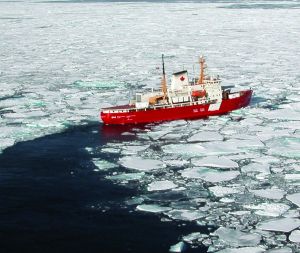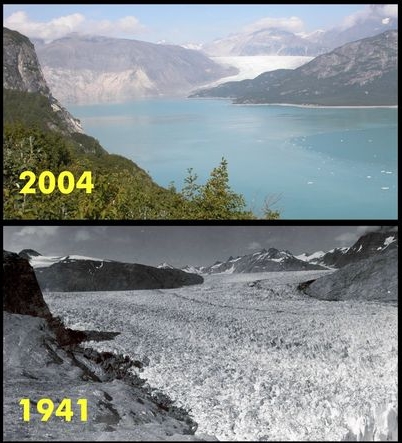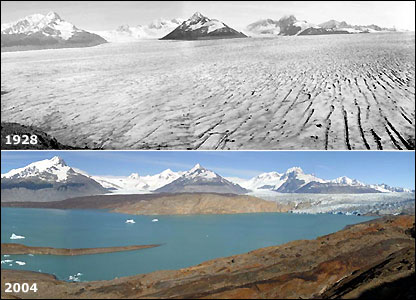 By Stephen Leahy; UXBRIDGE, Canada, Feb. 1st, 2011 (IPS)
By Stephen Leahy; UXBRIDGE, Canada, Feb. 1st, 2011 (IPS)
melting sea ice is now locked into a death spiral.
“The changes in the Arctic are now irreversible”
Arctic Defrost Dumping Snow on U.S. and Europe
By Stephen Leahy; UXBRIDGE, Canada, Jan 28, 2011 (IPS)
The world’s northern freezer is on rapid defrost as large volumes of warm water are pouring into the Arctic Ocean, speeding the melt of sea ice, according to a new study.
Surface temperatures in parts of the Arctic have been 21 degrees C, 38 degrees F, above normal for more than a month in recent weeks.
“Boats were still in the water during the first week of January,” said David Phillips, a senior climatologist with Environment Canada, referring to southern Baffin Island, some 2,000 km north of Montreal. This is a region that receives just four or five hours of weak sunlight during the long winter. Temperatures normally range from -25 to -35 degrees C but were above zero on some days in January.
“It’s impossible for many people in parts of the eastern Arctic to safely get on the ice to hunt much-needed food for their families – for the second winter in a row,” Phillips said in a report.
The warming and melting of the Arctic is happening much faster than expected and new data reveals that huge volumes of warmer water from the North Atlantic are now flowing into and warming up the Arctic Ocean, researchers reported Friday in the journal Science.
“What’s happening here is very unusual compared to the last 2,000 years,” Marchitto told IPS. Over 90 percent of additional heat trapped in the atmosphere, from the burning of fossil fuels like coal, oil and natural gas is going into the oceans, he said.
The warming Arctic and melting sea ice is a planetary-scale change since the Arctic Ocean covers 14 million sq km, an area almost as big as Russia. The Arctic and Antarctic polar regions are key drivers of Earth’s weather and climate. The rapid defrosting of the Arctic has already altered the climate system, researchers now agree.
As more and more sea ice melts, there is more open water to absorb the summer sun’s heat. A day of 24-hour summer sun in the Arctic puts more heat on the surface of the ocean than a day in the tropics, James Overland of the NOAA/Pacific Marine Environmental Laboratory in the United States told IPS.
That extra heat in the ocean is gradually released into the lower atmosphere from October to January as the region slowly re-freezes months later than normal. This is a fundamental change – a large part of the Arctic Ocean is radiating heat instead of being cold and ice-covered. That has disrupted wind circulation patterns in the northern hemisphere, reported Overland and other researchers at the International Polar Year Oslo Science Conference in Norway last June.
The result: the Arctic stays warm and mid-latitude regions become colder and receive more snow for much of the winter.
Glaciers Disappearing
http://www.livescience.com/674-glaciers-disappear-photos.html
Glacier National Park, only 26 of 150 named glaciers remain
The Montana park has 26 named glaciers today, down from 150 in 1850. Those that remain are typically mere remnants of their former frozen selves. For several years now, scientists have predicted that the park will cease to have glaciers by 2030, but trends in recent years have some revising that estimate to 2015-2020.the world’s fastest-melting glacier
The Columbia Glacier in Prince William Sound, the world’s fastest-melting glacier, slides into the ocean at a rate of 80 feet per day. This tidewater glacier is up to 3,000 feet thick, but it has thinned up to 1,300 feet in places during the past 25 years, and researchers say it’s stretching like taffy. Each year, it dumps 2 cubic miles of ice into the sound.
In Greenland it’s common nowadays for glaciers to recede several miles in one year.sometimes glaciers can weaken to the point where they suddenly, and noisily, collapse. One dramatic example of a quick break is the Larsen B ice shelf in Antarctica
Along with glacial melting, permafrost around the globe is turning to mush, causing ground to simply collapse.
Summers in parts of the Arctic could be ice free in the next 100 years, which could prove daunting for the existence of polar bears.
Last December was the coldest south Florida has experienced in more than a century of record-keeping.
This looks to be the new normal since Arctic experts agree the melting sea ice is now locked into a death spiral.
“In future, cold and snowy winters will be the rule rather than the exception” in the eastern United States and Europe, Overland previously told IPS.
This week the U.S. northeast suffered through its sixth major snowstorm this winter, breaking all snowfall records.
The changes in the Arctic are now irreversible
Scientists have been surprised by the rapid warming of the Arctic, where annual temperatures have increased two to three times faster than the global average. In one part of the Arctic, over the Barents and Karas Seas north of Scandinavia, average annual temperatures are now 10 degrees C higher than they were in 1990.
“This is a very big change for the entire planet,” said David Barber, an Arctic climatologist at the University of Manitoba in Canada. The planet’s cold polar regions are crucial drivers of Earth’s weather and climate.
“It has been one million years, some think 14 million years, since the Arctic was ice-free,” Barber told the more than 2,300 researchers in Oslo at the largest-ever gathering of the polar-science community.
One of the largest winter storms since the 1950s has hit 30 U.S. states from New Mexico to Maine and now into central and eastern Canada. Over 100 million people affected, hundreds of thousands without power. Chicago could get buried by more than 60 centimeters (2-ft) of snow – hundreds stranded already.
1. Because of warmer global temps, there is now four per cent more water vapour in the atmosphere which means heavier snowfalls.
2. There is also more energy in the climate system which makes storms more powerful.
3. Finally the melting of the Arctic sea ice is changing wind patterns in the polar regions and bringing colder, wetter winters to the eastern US and western Europe, scientists told me several months ago. (See my previous post East Coast Blizzard and Europe’s Snowmaggddon Reveal Fingerprints of Climate Change
Ice Breakers
“Much of the remaining ice in the Beaufort Sea is rotten,” said Barber, who spent long periods on research icebreakers in the region. Such vessels can only break through ice a little over a metre thick but, last September, David Barber was on board the Canadian icebreaker CCGS Amundsen (pictured above), heading into the Beaufort Sea, north of Alaska. they were plowing through multi-year ice 14 metres thick, he said.
“We watched a piece of ice the size of Manhattan break up right before our eyes,” Barber said.
Although the ice recovers in winter and satellites recorded a full recovery this past winter, in reality much of it was a thin layer of ice on top of old rotten ice, he said. That explains the rapid decline already this year, a near-record low for May. At the end of the Arctic summer, the decline will likely come close to setting another new record, many here said.
Barber says an ice-free summer may be just three or four years away, when icebreakers will no longer be needed to navigate the region.
“The ice pack looks like Swiss cheese,” agreed Mark Serreze, a senior research scientist at the National Snow and Ice Data Centre in Boulder, Colorado.
Temperatures in January were -2C over the water, while the land was -25C, making conditions far windier and producing more snowfall than normal . Heavy snow on the remaining ice insulates it from the cold air, preventing it from thickening during the long winter.
The winter of 2005-6 was the coldest in 50 years
in Japan and eastern Eurasia, reported Meiji Honda, a senior scientist with the Climate Diagnosis Group at Japan’s Agency for Marine-Earth Science and Technology. Honda’s studies show that the air over the Arctic was quite warm in the fall of 2005 , which altered normal wind patterns, pushing the jet stream further south and bringing arctic cold to much of Eurasia and Japan. He also documented the same mechanism for the colder winters of 2007-8 and 2009-10, he told participants.
In eastern North America, the same conditions of 2007-8 produced increased precipitation and colder temperatures in the winter. As the sea ice declines, big impacts are likely to be seen in this region, said Sara Strey of the University of Illinois.
Another “wild card” in terms of effects from the Arctic warming is how much and how fast the region’s permafrost – permanently frozen landscape – that contains enormous amounts of carbon and methane will also melt.







